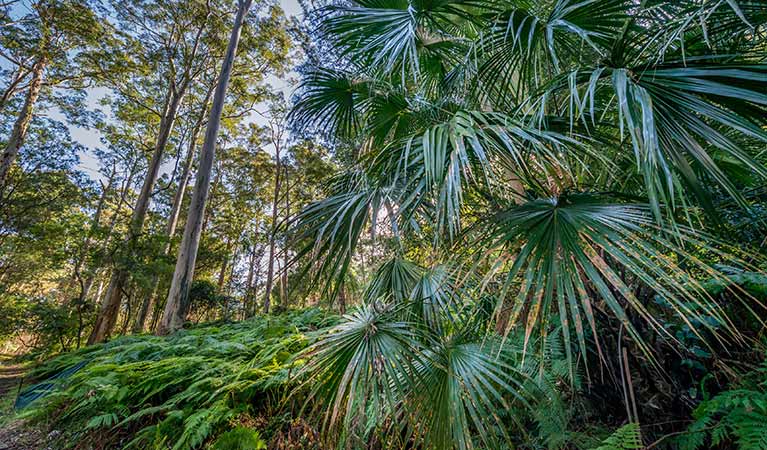
Many residents of Kangaroo Valley will know that a main language spoken by the Indigenous people with custodianship of the Valley before it was settled by Europeans and continuing to this day is the Dharawal (Tharawal) language. It might be less well-known that the meaning of Dharawal is cabbage tree palm (Livistona australis).
The cabbage tree palm was found in profusion right up and down the coast, particularly from Botany Bay to the Shoalhaven, and correlates with the land of the Dharawal-speaking people. Today, these beautiful palm trees often stand tall as the one remaining tree in an open paddock.
The National Parks and Wildlife Service describe the cabbage tree palm as having leaves that span 3-4m in length and a trunk reaching a height of up to 30m, making it one of the tallest native Australian plants. It thrives in the rainforest margins along the east coast of NSW and, in summer, it produces striking spikes of cream flowers which resemble cabbages. It now has a protected conservation status in NSW.
Connection with Kangaroo Valley
Dharawal Elder and respected historian, the late Les Bursill OAM, has written about the cabbage tree palm in his autobiography, The Past is in us, not Behind us (2019, Sutherland Shire Reconciliation). Interestingly, Les Bursill’s great-great-grandparents were William and Susan Rollan, the first interracial couple in Kangaroo Valley, who married in 1846 in Albion Park. They had six children who went to the local school at Calderwood. They had the right to attend school as their father was English.
Susan was the daughter of an Indigenous man, Karradju (clever man), also known as Dr Ellis, who was the leader of the Kangaroo Valley Aboriginal people from the Bong Bong clan. He is credited, among many other things, with showing Henry Osborne the walking tracks from Kangaroo Valley to Moss Vale. He was highly regarded by the botanist William Macarthur because of his extensive knowledge of plants. One of the things he is said to have pointed out to Macarthur is that cabbage tree palms will have different names when they grow near the seashore, a lakeside or a mountain range.
Many uses
Bursill states that, prior to the coming of Europeans, clan life revolved around the cabbage tree palm as it provided the foundation to their daily sustenance. Water buckets were made by tying up each end of the palm frond. The fronds were also used to build shelters. The long slender trunks were straddled across creeks to make bridges. The twine from palm fibres was used in the making of fishing lines and rope.
According to the State Library’s Dictionary of Sydney, the tip of the tree is edible and was called ‘cabbage’ by European settlers, although eating it will kill the tree. The cabbage tree hat, donned by settlers, became famous in the colony and is part of the folklore.
Sarah Waddell
on behalf of
Reconciliation Allies Kangaroo Valley